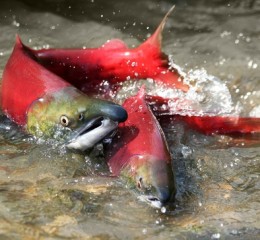


The salmon family is vast. There are 6 species that are especially used these days: the Royal or Chinook salmon (Oncorhynchus tshawytscha), the Red salmon (Onchorhynchus nerka), also called Sockeye, the Silver or Coho salmon (Oncorhynchus kisutch), the Pink salmon (Oncorhynchus gorbuscha), the Keta salmon (Oncorhynchus keta) also called Dog salmon and the Atlantic salmon or Salmo salar. All salmon are what are known as anadromous, ie they are born in fresh-water, later live in salt water … and then return to fresh-water to spawn. That's also a characteristic of sturgeon with eggs that become caviar (see Caviar). Salmon have been fished since the beginning of time. To combat the diminution in their numbers in their natural habitat, Scotland and Norway started farming them in the Sixties. Initially it was a restocking project with young salmon being transferred to rivers.
Today, 93% of the Atlantic salmon that reaches our tables is farmed. But for the Pacific salmon (Royal, Red, Silver, Pink and Keta) only about 12% is farmed. There are substantial differences in both taste and appearance between the various species. Pink salmon is the least rated, while the Royal and the (wild) Atlantic are considered the very best. In Canada and Alaska, salmon fishing is one of the major tourist attractions. In the rivers which flow into the Pacific and the Bering Sea it is possible to find the majestic Royal salmon (from July onwards) or the spectacular Red on the salmon run back up the river to where it was born so it too can reproduce.
The Royal, or Chinook, salmon (Oncorhynchus tshawytscha) lives towards the north of the Pacific Ocean. This salmon can grow to 1 metre and weigh more than 20kg. The very largest Royal salmon has been recorded at 57kg! That allows you to understand why it is sought by lovers of fishing. It can live for 5 – 8 years. Its tender skin is especially delicate and its colour varies between light pink and dark orange. It is mostly sold as a wet fish, but it is also used for smoking. A great traveller, it is capable of swimming 1500km so it can return to the spawning grounds of its birth.
The Red salmon (Onchorhynchus nerka), also called the Sockeye, lives in the north-east Pacific. It eats krill (small shrimps). When it goes back up the rivers to spawn, this salmon undergoes two changes: its head becomes green and, more spectacularly, its body becomes a bright red. Like the flamingo it owes its colour to its food (shrimps) which transfer these pigments. They are stocked in the organism until spawning occurs. This change of colour indicates to its fellow-fish that it is ready to reproduce. This salmon's skin is firm and has a characteristic taste.
The Silver or Coho salmon (Oncorhynchus kisutch) has silver lights on its sides, while its back is deep blue with some irregular black spots. It lives principally on the coast of British Columbia in Canada. The young Coho are very aggressive and territorial. Their brilliant colours include an orange mark on the anal fin. The young Coho spends its first year in rivers and then goes to the Ocean where it stays at least 18 months before going back up the river in which it was born, so as to spawn. When laying her eggs, the female hollows out 5 'nests' in the sand and deposits between 800 – 1000 eggs in each one.
The Pink salmon (Oncorhynchus gorbuscha) is the smallest of the species (less than 50cm long and weighing less than 2.5kg). This is, without doubt, because the alevins, scarcely born, go out to the Ocean. They very quickly (2 years) reach sexual maturity, which is why they are once again to be found throughout Canadian waters. Yet, like all Pacific salmon, the Pink salmon dies after it has reproduced, ie after just two years. It is also called the humpback salmon because of the male's spectacular deformation at the time of reproduction. It is less highly rated than its cousin, the Chinook, because of its soft skin and small size.
The Keta salmon (Oncorhynchus keta) is also called the Dog salmon because its canine teeth become prominent when it is time for reproduction. It lives mainly off the north-west coast of North America. But it is also fished from the Californian coast up as far as Canada, in Russia (the Bering Sea) and in Japan. This Pacific salmon is close to the Pink salmon in terms of size (less than 1 metre) and shape; but the male can be distinguished by the violet-coloured grooves on an olive-green background at the time of reproduction. The Keta lives 4 years between birth and spawning (and its death). Its growth accelerates before the period of reproduction, when it will prepare to go back up the river. The largest fish are found near the coastline. There are no farmed Keta salmon.
The Atlantic salmon, or Salmo Salar, is a magnificent athlete which swims much faster than a trout. A bright silver colour, its grey back can be more or less blue in the sea. In the river it becomes copper-coloured. Its natural milieu is vast, extending over the whole North Atlantic, from the Hudson River to the Baltic Sea. The area where it fattens itself up is to be found to the west of Greenland, in the north Faeroe Islands and in the sea off Norway. Unlike its Pacific cousins, it spawns between 2 and 4 times in its life – so effecting as many migrations in the sea as in the fresh-water. It is also farmed, especially in Norway.